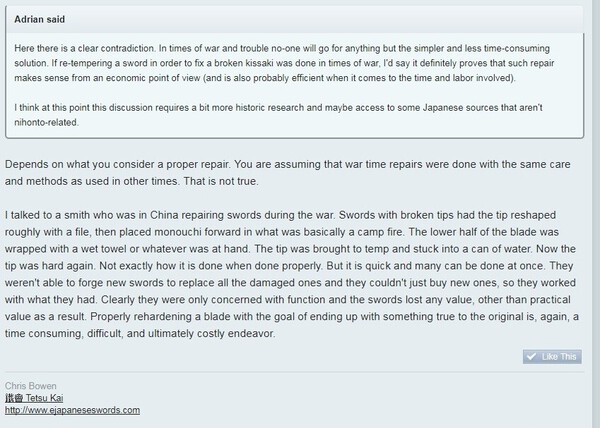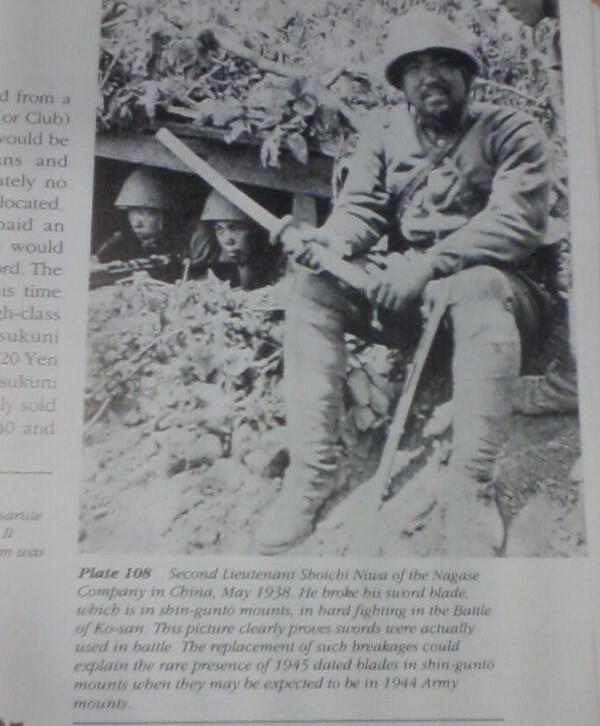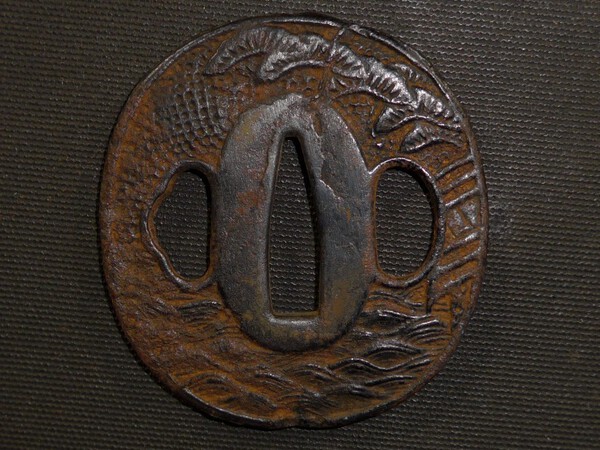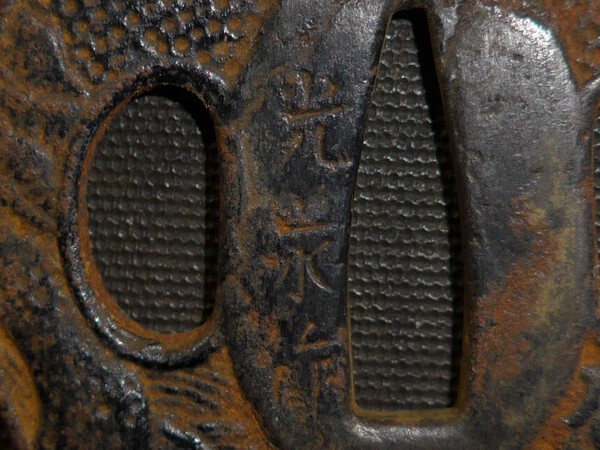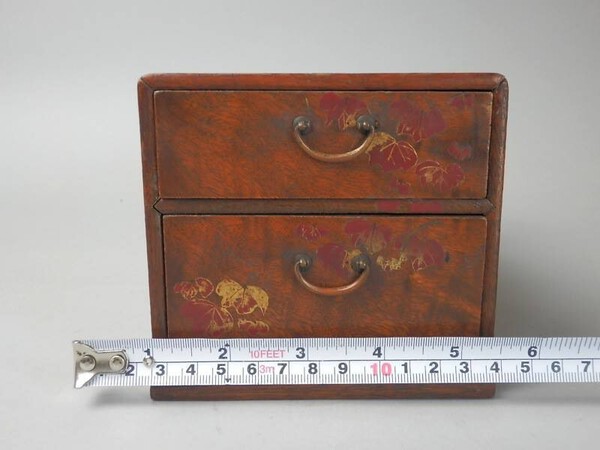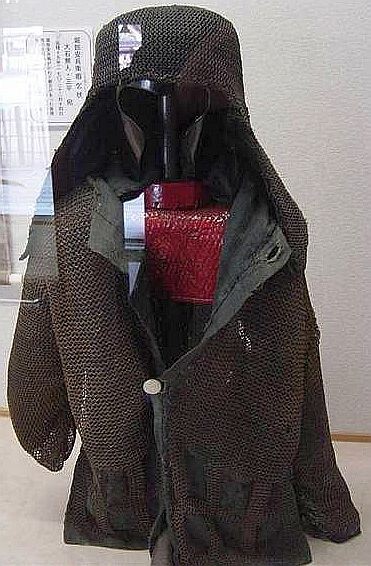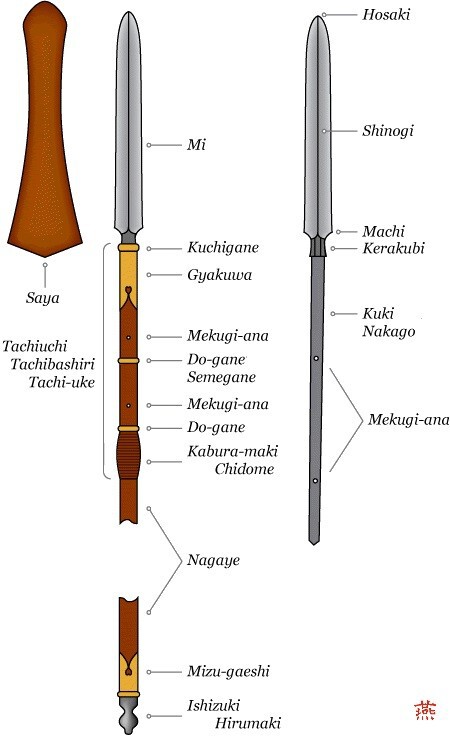-
Posts
1,686 -
Joined
-
Last visited
-
Days Won
12
Content Type
Profiles
Forums
Events
Store
Downloads
Gallery
Everything posted by Dave R
-

WW2 made Wakizashi - How common are they?
Dave R replied to robinalexander's topic in Military Swords of Japan
As you say, never say never! But to put it bluntly, this was a well dodgy thing to do and driven by necessity/desperation and not choice. I will let someone more knowledgeable than I answer you. A screenshot from a conversation some years ago, and a photo taken in the field. -
Personal opinion, this is one of those dreadful "dealers specials" where a part is replaced for one reason or another. The blade, saya and tsuba are classic Shin-Gunto, and the tsuka is a random piece from the bit box! That is why there is no habaki, either lost during the strip down or earlier, or left off so that the mekugi-ana align. There is a remote possibility that that this was a field repair, but no IJA officer would ignore the habaki, and a new mekugi-ana would have been just drilled through, as we are familiar with on older swords that have been refitted in their working life.
-

WW2 made Wakizashi - How common are they?
Dave R replied to robinalexander's topic in Military Swords of Japan
On a Showato only as a quick and dirty fix in the field during the war, so it's very uncommon....It would be visible to a trained eye and the value of the blade gone forever so no point in retaining the mei. But why suggest such a rare thing when there is solid evidence for Showa made wakizashi.http://www.ksky.ne.jp/~sumie99/flaws.html -

WW2 made Wakizashi - How common are they?
Dave R replied to robinalexander's topic in Military Swords of Japan
Both swords still have signatures and stamps on the tang, so they are as they were made. Showa blades can depart widely from tradition, blade shape, blade material and forging technique. Amahida made some very different blades to traditional, a conversation on this site linked here. -
The blade has a mirror/buffed finish, which means it has been stripped and reassembled. All bets are off!
-

WW2 made Wakizashi - How common are they?
Dave R replied to robinalexander's topic in Military Swords of Japan
As has been said, most wakizashi in gunto mounts are old blades new mounted for the emergency... But I found these two in my files. Both Seki stamped so no doubts about when they were made. -

Need help with blade tang signature on Shin gunto sword
Dave R replied to PeterCollector's topic in Translation Assistance
I have used a .177 air rifle cleaning rod to wipe/scrub inside saya before now. Not ideal but better than nothing if you cannot remove the liners. -
I wouldn't worry about getting off subject. I post to start conversations as much as get information about pieces in my collection (hoard). I would guess that the vendor has little interest in showing off detail! I have also noticed that a lot of iron tosugo is posted on seller sites with little or no cleanup..... possibly because antique dealers and collectors in general as opposed to Nihontophiles like the "Fresh to the Market" uncleaned look. Possibly because a proper job involves work and time they begrudge an item they want to sell on as quickly as possible.
-
I don't see a bayonet, but I do see a hanging strap on the left side that might be the gurometto or sword hanger. The leather ones seem to have lost the clip on the end on more than one occasion. I reckon Shanghai Naval Landing Force, especially with the armoured car in the background.
-
Or this...
-
Thank you for this information. I think I might even hang onto it rather than chucking or selling it on. It's surprising what moves on eb'y even with honest caveats.... though whether the buyers pass it on like that is another matter. I have sold some out and out fakes, clearly labelled as such to educators who wanted cheap examples that that they could use and lose without sorrow.... Or dress up for a showpiece on a costume/cosplay.... it would make a good eye-patch!
-

Re-polishing after Tamashigiri?
Dave R replied to Okan's topic in General Nihonto Related Discussion
As I understand it they just didn't polish to the current level at all, back when they were a weapon rather than an art object. Somewhere I read that the last two stones only became common in the Meiji period. -

WW2 made Wakizashi - How common are they?
Dave R replied to robinalexander's topic in Military Swords of Japan
If you are going to do cutting practice, using old mounts is risking your own and others safety, and similar issues with old blades, though cost could be the main factor here..... Or a belief that a new blade would give better results! -

WW2 made Wakizashi - How common are they?
Dave R replied to robinalexander's topic in Military Swords of Japan
Pre war Showa there was a bit of a revival in sword arts, and you can find Showa era blades in traditional style mounts. Often there were shortcuts in the forging, and once the rules came in, they would be stamped to show this. I have about a dozen of these on my computer files, and a handful are Wakizashi. -

WW2 made Wakizashi - How common are they?
Dave R replied to robinalexander's topic in Military Swords of Japan
The fuchi/kashira is of the late war type, and non-regulation menuki are not unknown and in this case could even be from the original koshirae, like the saya. According to Mr Komiya there is no such thing as a Gunzoku koshirae in the regs. but we see this type turn up again and again, so might be more due to exigencies of service than anything else. According to regs. the defining feature of a Gunzoku sword is an army length plain brown silk sword knot. The IJN one is shorter and a different shade of brown. (Mr Komiya admits that he is not a "sword guy", but he is The Man for IJA documents) The tsuba is of the "Bamboo leaf" design, not at all common but well known. All in all a typical late war package of an old sword, or in this case a pre-war Buke zukuri Showato remounted to go on military service. -
... What date are we looking at for these cast tsuba then, late 19th or 20th century? I expected it to be a cast item because of the "soft" look to the signature. ... And yeah, I have a few different tsuba in the spares box. Like I said, I won it cheap on ebay, so no great expectations of it.
-
Pretty much what I think as well, but at the price, I am not bothered. (cheap enough to wear for cosplay!) As for the tsuba, yeah I am pretty sure its cast as well, but the question is when? The rest of the fittings... well it's a Chonin sword with signs of wear, so pre 1872 when all sword wearing was banned. Not a high class merchant, probably somebody like one of these guys, second hand clothes dealers in the big city.
-
.... and a few more, including one that I took of what came out of the parcel. The tsunagi is no real loss as it was a random piece inserted to hold it together and had been "buggered to fit".
-
Having just seen a post about current shipping problems I am very aware of having just got this in time, (arrived yesterday)... and i no longer begrudge the shipping fee, which was more than the cost of the ensemble. I use the word advisedly because I have no idea if this package started life together or if it's just a collection of parts, assembled by the dealer. At the price paid, which was less than I would expect for any single item, saya, tsuka or tsuba I have no gripes or issues, though I would have liked the junk tsunagi to have arrived in one piece. Vendors photo's for the most part.
-

EMS from Japan to UK has stopped.
Dave R replied to Paz's topic in General Nihonto Related Discussion
-
Here's my contribution to the fun, described as a "Japanese ANTIQUE WOOD TANSU FURNITURE DRAWER KODANSU LACQUER DESING LEAF NR" and bought from Japan via Ebay in 2013. I use it for small items like seppa and koduka. I guess its Taisho at the oldest, but I like it.
-
You would be surprised at how much stuff was made using "patrices" and "matrices", positive and negative moulds for thin metal stamping's. Its a technique that goes back thousands of years, for fine detail you hammer into the negative mould, usually using a lead filler or back. Most of the foils on Roman and Germanic items were done this way. https://en.wikipedia.org/wiki/Torslunda_plates Silversmithing 101. D. Rushworth 22 BA Hons', 3d art and design Google will disappoint, because google is silicon valley stoopid.
-
It can happen, but it's a lottery with the same chances as for a big win. The "one in a million" that I got was bought to be used as an example or "pattern" without any intention or hope of it fitting, so a big surprise when it did! More usually I buy a sound but shabby piece, with damaged or absent Ito, ( would never ever cut the ito on a good piece) and throw it into water for a few hours so the rice glue dissolves. Then I do whats necessary to make it fit. I have found a few where I was not the first retro fitter with things like plugged Mekugi Ana and glued in shims or fillets of Honoki and showing signs of age. Certainly done in Japan anyway.
-
You beat me to it with the comment about the 47. Frankly they would not have cared less about sword length law. They were on a revenge mission and knew they would be forced to suicide afterwards, and had armed and armoured themselves secretly so not to alert the authorities!
-
I dunno about that, it's a very mutilated blade if it is, with no base "kerakubi" to the blade. I would also say that even the very short styles of yari, for inside a litter or Kago/Palanquin have a different style of mount, yari sometimes even mounted as daggers/tanto! I think we see a Meiji period Western style triangular bayonet mounted as a yari here.


